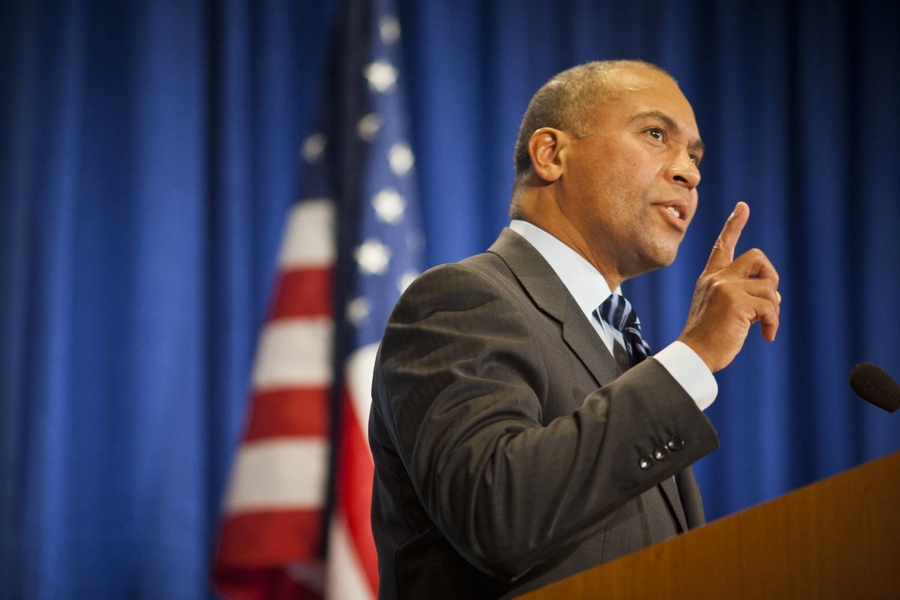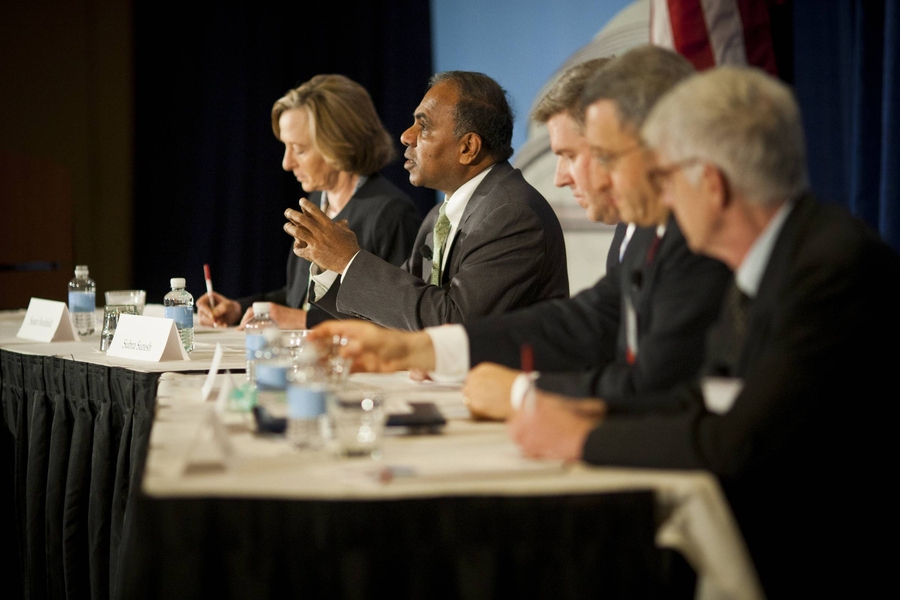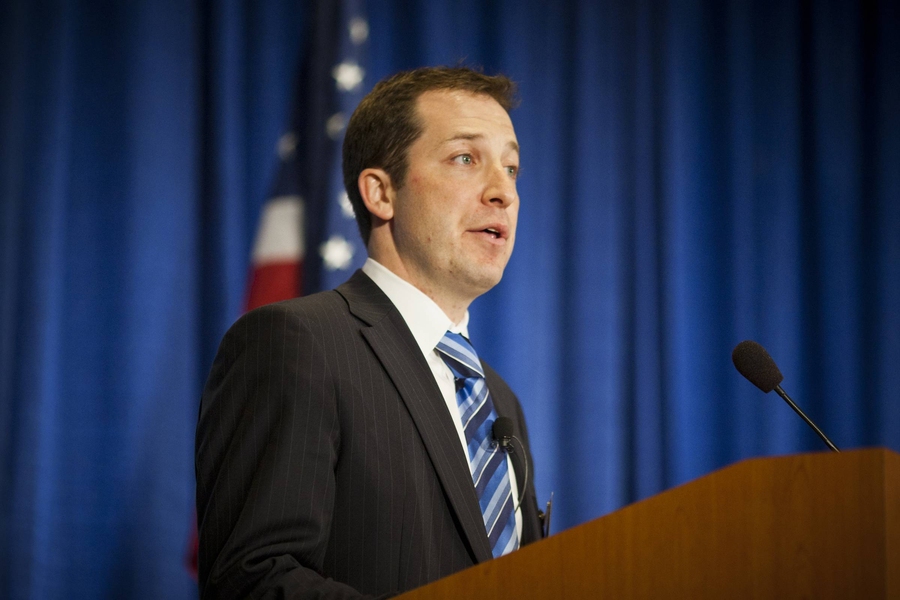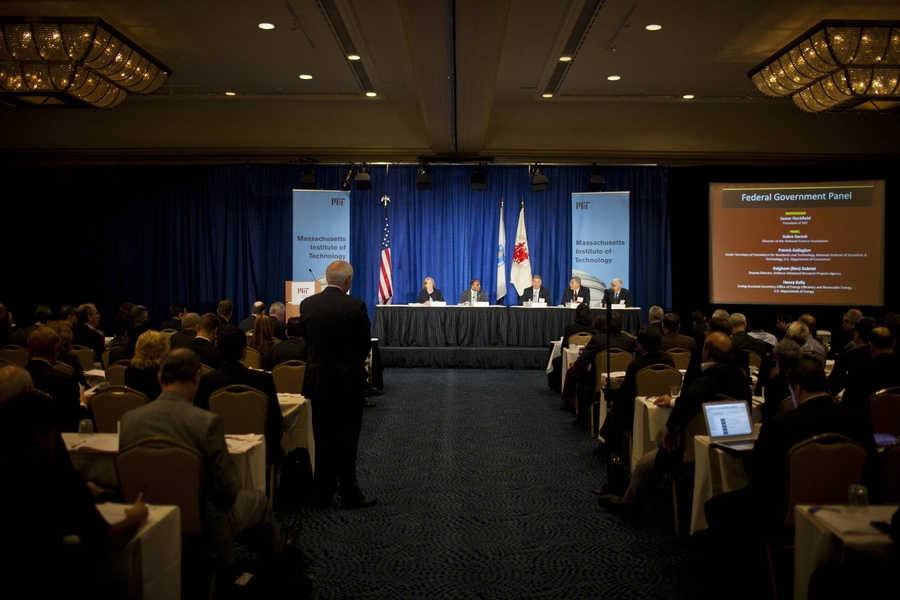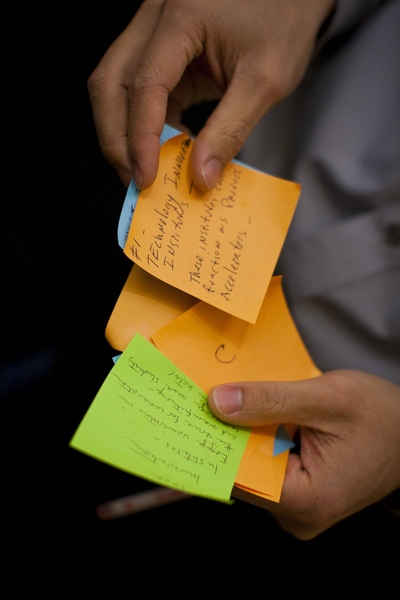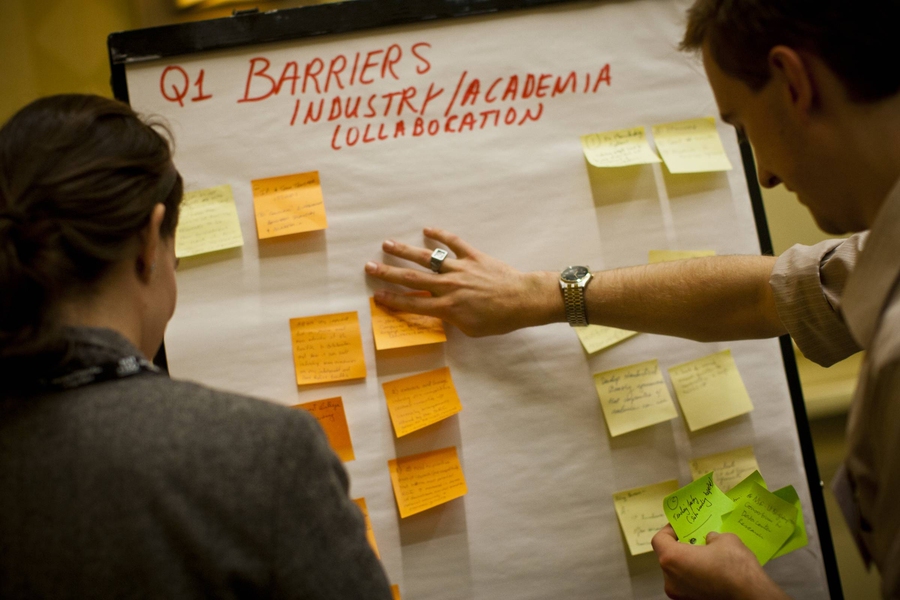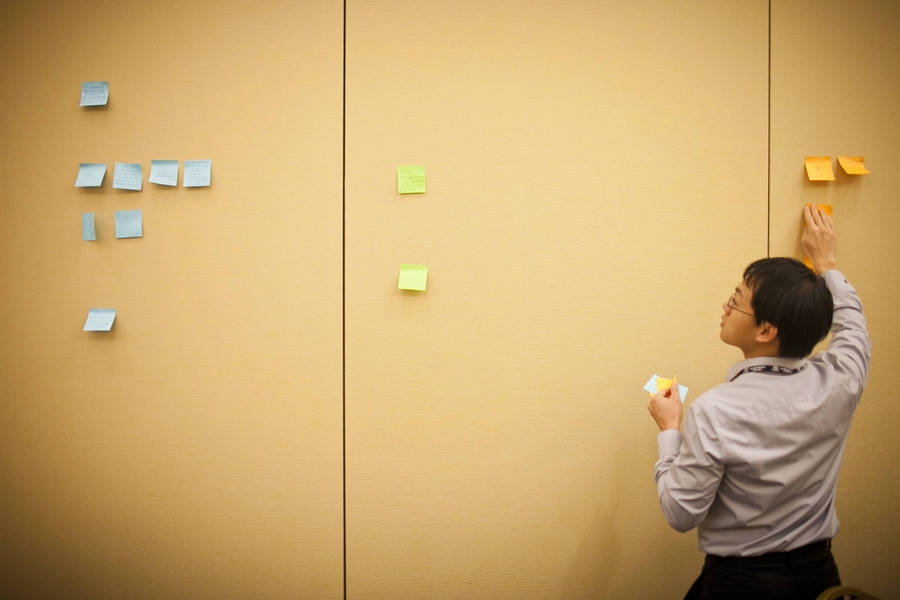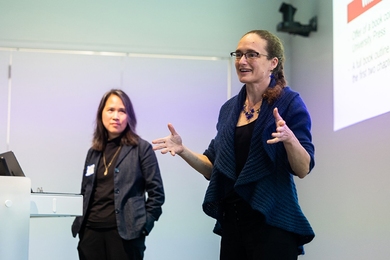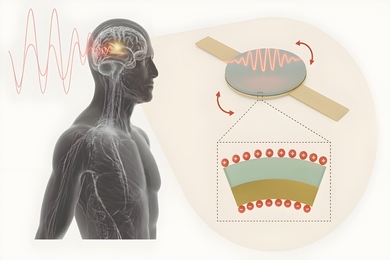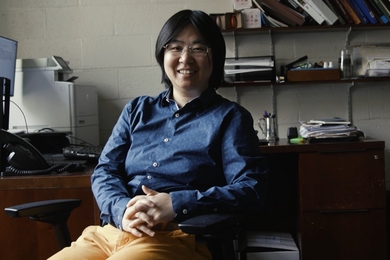A cohort of leading engineers, scientists, business executives and government officials gathered at MIT on Monday for a daylong forum, part of a White House initiative with an ambitious goal: turning America’s abundant laboratory advances into new technologies that will jump-start the U.S. economy.
The meeting was part of the Advanced Manufacturing Partnership (AMP), created by President Barack Obama in June, which will deliver specific policy recommendations on manufacturing industries to the administration next spring. The meeting was the second of four regional workshops intended to stimulate interest in and promote local connections around a prospective renaissance in American manufacturing.
AMP’s premise is that there exists a substantial “innovation gap,” as many forum participants called it, in which not enough of the country’s research discoveries move on to form the basis of viable businesses. Helping those innovations move into the marketplace could strengthen the nation’s manufacturing sector and reverse the sector’s long decline in employment.
“There are many in this nation who are convinced that nothing is made in America anymore,” MIT President Susan Hockfield said in her opening remarks at the event. “The truth is that manufacturing remains a key sector of our economy.” Hockfield, along with Dow Chemical Co. CEO Andrew Liveris, are co-chairs of AMP’s steering committee.
Yet if the innovation gap seems simple to describe, the solutions to it will require a complex of actions, from the classroom to the shop floor.
“If our manufacturing sector is to rise again, it will take an aggressive mix of answers, including new processes and business models, new education and training efforts, and unprecedented new technologies,” Hockfield said. Pursuing those answers, Liveris added in video-recorded remarks, represents a “conscious choice” to help manufacturing evolve along new pathways.
Indeed, as White House officials emphasized, the challenge of AMP is to identify and support new areas of manufacturing activity. Some of these areas may be in existing fields such as biotechnology, energy and robotics; others lie in evolving fields such as nanotechnology and advanced materials, where advances could create either specific products or new techniques that could apply to many industries.
“It’s not about some desire to return to a romantic notion of the past,” said Jason Miller, the White House’s special assistant to the president for manufacturing policy.
And a revival of manufacturing, as Massachusetts Gov. Deval Patrick noted, seems likeliest to occur through cooperation between government, industry and academia.
“We cannot do it alone,” Patrick said. “Industry cannot do it alone, and the universities cannot do it alone. But working together, we can.” In his remarks, Patrick also announced the creation of a new statewide group, the Advanced Manufacturing Collaborative, with an aim similar to that of the AMP.
From startups to scale-ups
The AMP event featured an array of 30 talks before an audience of several hundred people. Government officials at the forum emphasized that scientific research remains an area of U.S. strength.
“Our competitive advantage is clearly innovation-based technology,” said Henry Kelly, an acting assistant secretary in the U.S. Department of Energy.
Much of the discussion throughout the day dove specifically into a pair of related topics: finding the best ways to help innovations reach the market, and, secondly, keeping the manufacturing jobs that arise from new innovations in the United States.
When it comes to commercializing research, one challenge for AMP is to figure out how best to help university scientists connect with manufacturers. “There is a discontinuity between academic research and industrial needs [that is] particularly pronounced in manufacturing,” said Andre Sharon, a mechanical engineering professor at Boston University. Speakers on one panel described a variety of emerging university-industry partnerships, from nanotechnology to stem-cell research, that aim to make applied research a more central part of their organizations.
Another set of challenges involves finding ways to help innovative small firms expand. Some of these concern funding: The credit crunch has made small-business loans harder to come by. But many speakers at AMP cited an additional problem: getting skilled technologists to stick with manufacturing firms and follow through with the often-arduous process of not just hitting on an innovation, but delivering it to customers.
“The big problem, and the one we really haven’t solved at all, is that while we’re quite good at supporting the efforts that lead to startups, we’re really very poor at supporting the research and education that would help startups to scale up,” said Suzanne Berger, the Raphael Dorman and Helen Starbuck Professor of Political Science at MIT, who is helping lead the Institute’s own study group on manufacturing, Production in the Innovation Economy (PIE).
A related concern expressed by many speakers at the AMP meeting was a shortage of skilled workers in leading-edge areas of manufacturing; despite high overall unemployment, executives of biotech and device-making firms, among others, said they frequently cannot find enough well-trained workers to help them reach production capacity. The long-term prospect of training a skilled workforce is “America’s greatest challenge,” said Raymond Stata, chairman of Analog Devices, the Cambridge-based semiconductor firm.
Where the jobs are
Even if a new wave of manufacturing firms blossoms in the United States, there is no guarantee that the operations of those firms will remain in this country. New Jersey, for instance, has seen its number of manufacturing jobs shrink from 500,000 to 250,000 over the last couple of decades — a disappearance of the jobs that formed “the backbone of the middle class,” noted Aaron Fichtner, a commissioner in that state’s Department of Labor.
And yet firms that shift their factories overseas, in pursuit of lower labor costs, may be shooting themselves in the foot.
“Most people, when they do the math, overestimate labor costs and underestimate supporting costs,” said Marc Giroux, a senior vice president and chief engineer at Corning Inc., the manufacturer of high-tech glass and optical fiber. The bulk of Corning’s manufacturing remains in the United States, he added, because that allows the firm to maintain its product quality, and helps the process of manufacturing new devices.
“Being in the same time zone and speaking the same language is important for innovation,” Giroux said. Where possible, he said, Corning aims for a “close coupling of research and development and manufacturing.”
Executives of some of the smaller firms represented at the event offered a similar perspective. Jill Becker, the CEO of Cambridge NanoTech, a firm making ultrathin films that can be used in solar-energy products, electronic devices, biomedical tools and more, even promised signaled she would keep all her manufacturing in Massachusetts, should the firm grow (it currently has about 40 employees).
Monday’s forum was one of four regional AMP meetings before the group delivers its report next year. The first such event was held Oct. 14 at the Georgia Institute of Technology, with the next two scheduled to be held at the University of California at Berkeley and the University of Michigan.
MIT’s participation in the project, Hockfield noted, is in keeping with its long tradition; the Institute was founded 150 years ago, she said, with the “express purpose of accelerating America’s industrial progress,” and thus helping the country’s prosperity.
“Manufacturing is in our DNA,” Hockfield said.
The meeting was part of the Advanced Manufacturing Partnership (AMP), created by President Barack Obama in June, which will deliver specific policy recommendations on manufacturing industries to the administration next spring. The meeting was the second of four regional workshops intended to stimulate interest in and promote local connections around a prospective renaissance in American manufacturing.
AMP’s premise is that there exists a substantial “innovation gap,” as many forum participants called it, in which not enough of the country’s research discoveries move on to form the basis of viable businesses. Helping those innovations move into the marketplace could strengthen the nation’s manufacturing sector and reverse the sector’s long decline in employment.
“There are many in this nation who are convinced that nothing is made in America anymore,” MIT President Susan Hockfield said in her opening remarks at the event. “The truth is that manufacturing remains a key sector of our economy.” Hockfield, along with Dow Chemical Co. CEO Andrew Liveris, are co-chairs of AMP’s steering committee.
Yet if the innovation gap seems simple to describe, the solutions to it will require a complex of actions, from the classroom to the shop floor.
“If our manufacturing sector is to rise again, it will take an aggressive mix of answers, including new processes and business models, new education and training efforts, and unprecedented new technologies,” Hockfield said. Pursuing those answers, Liveris added in video-recorded remarks, represents a “conscious choice” to help manufacturing evolve along new pathways.
Indeed, as White House officials emphasized, the challenge of AMP is to identify and support new areas of manufacturing activity. Some of these areas may be in existing fields such as biotechnology, energy and robotics; others lie in evolving fields such as nanotechnology and advanced materials, where advances could create either specific products or new techniques that could apply to many industries.
“It’s not about some desire to return to a romantic notion of the past,” said Jason Miller, the White House’s special assistant to the president for manufacturing policy.
And a revival of manufacturing, as Massachusetts Gov. Deval Patrick noted, seems likeliest to occur through cooperation between government, industry and academia.
“We cannot do it alone,” Patrick said. “Industry cannot do it alone, and the universities cannot do it alone. But working together, we can.” In his remarks, Patrick also announced the creation of a new statewide group, the Advanced Manufacturing Collaborative, with an aim similar to that of the AMP.
From startups to scale-ups
The AMP event featured an array of 30 talks before an audience of several hundred people. Government officials at the forum emphasized that scientific research remains an area of U.S. strength.
“Our competitive advantage is clearly innovation-based technology,” said Henry Kelly, an acting assistant secretary in the U.S. Department of Energy.
Much of the discussion throughout the day dove specifically into a pair of related topics: finding the best ways to help innovations reach the market, and, secondly, keeping the manufacturing jobs that arise from new innovations in the United States.
When it comes to commercializing research, one challenge for AMP is to figure out how best to help university scientists connect with manufacturers. “There is a discontinuity between academic research and industrial needs [that is] particularly pronounced in manufacturing,” said Andre Sharon, a mechanical engineering professor at Boston University. Speakers on one panel described a variety of emerging university-industry partnerships, from nanotechnology to stem-cell research, that aim to make applied research a more central part of their organizations.
Another set of challenges involves finding ways to help innovative small firms expand. Some of these concern funding: The credit crunch has made small-business loans harder to come by. But many speakers at AMP cited an additional problem: getting skilled technologists to stick with manufacturing firms and follow through with the often-arduous process of not just hitting on an innovation, but delivering it to customers.
“The big problem, and the one we really haven’t solved at all, is that while we’re quite good at supporting the efforts that lead to startups, we’re really very poor at supporting the research and education that would help startups to scale up,” said Suzanne Berger, the Raphael Dorman and Helen Starbuck Professor of Political Science at MIT, who is helping lead the Institute’s own study group on manufacturing, Production in the Innovation Economy (PIE).
A related concern expressed by many speakers at the AMP meeting was a shortage of skilled workers in leading-edge areas of manufacturing; despite high overall unemployment, executives of biotech and device-making firms, among others, said they frequently cannot find enough well-trained workers to help them reach production capacity. The long-term prospect of training a skilled workforce is “America’s greatest challenge,” said Raymond Stata, chairman of Analog Devices, the Cambridge-based semiconductor firm.
Where the jobs are
Even if a new wave of manufacturing firms blossoms in the United States, there is no guarantee that the operations of those firms will remain in this country. New Jersey, for instance, has seen its number of manufacturing jobs shrink from 500,000 to 250,000 over the last couple of decades — a disappearance of the jobs that formed “the backbone of the middle class,” noted Aaron Fichtner, a commissioner in that state’s Department of Labor.
And yet firms that shift their factories overseas, in pursuit of lower labor costs, may be shooting themselves in the foot.
“Most people, when they do the math, overestimate labor costs and underestimate supporting costs,” said Marc Giroux, a senior vice president and chief engineer at Corning Inc., the manufacturer of high-tech glass and optical fiber. The bulk of Corning’s manufacturing remains in the United States, he added, because that allows the firm to maintain its product quality, and helps the process of manufacturing new devices.
“Being in the same time zone and speaking the same language is important for innovation,” Giroux said. Where possible, he said, Corning aims for a “close coupling of research and development and manufacturing.”
Executives of some of the smaller firms represented at the event offered a similar perspective. Jill Becker, the CEO of Cambridge NanoTech, a firm making ultrathin films that can be used in solar-energy products, electronic devices, biomedical tools and more, even promised signaled she would keep all her manufacturing in Massachusetts, should the firm grow (it currently has about 40 employees).
Monday’s forum was one of four regional AMP meetings before the group delivers its report next year. The first such event was held Oct. 14 at the Georgia Institute of Technology, with the next two scheduled to be held at the University of California at Berkeley and the University of Michigan.
MIT’s participation in the project, Hockfield noted, is in keeping with its long tradition; the Institute was founded 150 years ago, she said, with the “express purpose of accelerating America’s industrial progress,” and thus helping the country’s prosperity.
“Manufacturing is in our DNA,” Hockfield said.
